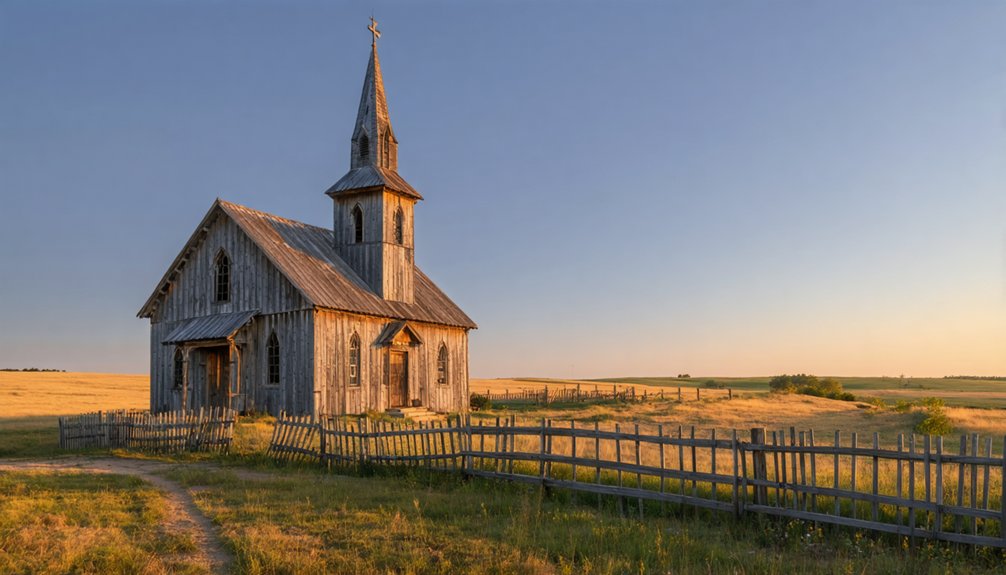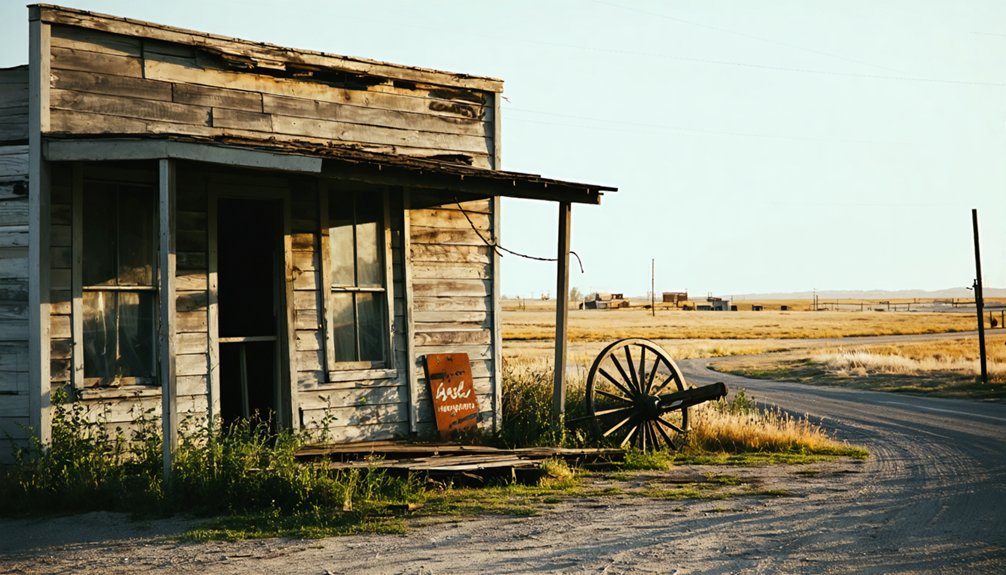You’ll find Gold Hill nestled in South Dakota’s northern Black Hills, where Custer’s 1874 expedition first discovered gold. This once-bustling mining camp near Deadwood and Lead attracted thousands during the Black Hills Gold Rush, with prospectors working placer deposits before shifting to hard rock mining by 1880. While little remains of the original structures today, you can still explore scattered foundations and mining remnants amid tales of ghostly miners and buried fortunes in the rugged terrain.
Key Takeaways
- Gold Hill emerged during the 1874 Black Hills Gold Rush after Custer’s expedition discovered gold, attracting thousands of miners by 1876.
- The settlement transitioned from placer mining to hard rock mining by 1880, with operations enhanced by stamp milling and chlorination processes.
- Daily life centered around makeshift settlements with tents and log cabins, while miners endured harsh working conditions and minimal law enforcement.
- The town declined in the early 1900s due to decreased mining profitability, leading to population loss and eventual abandonment.
- Today, only scattered foundations and rubble remain, with access requiring permission due to private ownership and safety concerns.
The Rise of Gold Hill During the Black Hills Gold Rush
After Custer’s 1874 expedition discovered gold in the Black Hills, Gold Hill emerged as one of many bustling mining camps during the frenzied rush that followed.
You’ll find this settlement nestled in the northern Black Hills region, near what would become the legendary mining towns of Deadwood and Lead.
As word spread of rich placer mining opportunities in the area’s creeks and gulches, thousands of transient miners flooded the region by 1876-77, defying the Fort Laramie Treaty with the Sioux Nation. The U.S. government attempted to purchase the land from the Sioux chiefs, but they firmly refused to sell their sacred territory.
The settlement’s population swelled with a diverse mix of fortune seekers from across America and abroad, all hoping to strike it rich in the stream gravels.
While many dreamed of easy wealth from surface gold, most would soon discover that the real fortunes lay in the deeper hard-rock deposits nearby. The most significant discovery was the Homestake Mining Company, which would go on to produce over 40 million ounces of gold.
Mining Operations and Economic Growth
The transformation of Gold Hill’s mining industry marked a pivotal shift in the region’s economic trajectory.
Placer gold deposits attracted thousands of early prospectors to the area. You’ll find that as placer deposits depleted by 1880, miners moved to complex hard rock operations, driving significant advances in mining technology. The Jones and Pinney Mill introduced stamp milling in 1876, while the 1880s brought revolutionary chlorination processes for extracting gold from stubborn ores.
This evolution in mining practices sparked remarkable economic impact throughout Gold Hill. Following the pattern of the Homestake Mine claim, which was purchased by George Hearst in 1877, many mining operations attracted substantial outside investment.
You’ll see how the industry fueled the growth of timber operations, railroad construction, and local businesses. While smaller mines eventually closed due to rising costs, the district’s significance endured through diversified mineral production including silver, mica, and feldspar.
The legacy of these operations lives on through preserved sites like Big Thunder Gold Mine.
Daily Life in Early Gold Hill
Daily life in Gold Hill revolved around hastily constructed settlements where miners packed into tents and log cabins near their claims.
You’d start your day at dawn, hauling tools to work the mines in physically demanding shifts. If you couldn’t afford your own shelter, you’d pay $1 for a cot in one of the crowded boarding houses. The Wild Bill Days drew thousands of prospectors searching for their own fortunes. The discovery of rich tin deposits in 1883 brought new life to the struggling mining community.
Community interactions centered on the “Bad Lands” district, where you’d find entertainment in saloons and dance halls after your daily routines.
You’d trade mining information, share labor, and negotiate with merchants for overpriced supplies like beans and salted meat.
With minimal law enforcement and limited medical services, you’d face constant challenges from claim disputes, workplace injuries, and poor sanitation.
Most of your social life involved card games, drinking, and occasional theatrical shows.
The Town’s Decline and Abandonment
Facing mounting economic pressures in the early 1900s, Gold Hill began its steady decline as mining operations became less profitable and ore deposits dwindled. Ghost town tourism attracts photographers and history buffs seeking to document the abandoned buildings.
The town’s economic vulnerability became apparent as it struggled to adapt to changing mining technology and stricter environmental regulations. Like many other Black Hills towns, Gold Hill’s fate mirrored the over six hundred ghost towns that emerged in the region. You’ll find that the lack of economic diversification left Gold Hill particularly susceptible to downturns, especially during the World Wars and Great Depression.
The abandonment of vital railway lines dealt another blow to Gold Hill’s survival, isolating the community from essential services and supplies.
As mining jobs disappeared, younger residents sought opportunities elsewhere, leaving behind an aging population. The town’s social fabric unraveled as schools closed and businesses shuttered.
Today, Gold Hill stands as a reflection of the boom-and-bust cycle of mining communities in the Black Hills.
Remaining Structures and Historical Landmarks
Modern visitors to Gold Hill will find little evidence of its once-bustling mining community, as time and neglect have erased most visible traces of the town’s existence.
You’ll need a keen eye to spot the scattered remaining foundations, which offer the only definitive proof of where buildings once stood. The landscape has largely reverted to empty fields and pastures, with occasional piles of rubble marking former structure locations. The Forest Service actively contributed to this desolation when they burned down buildings that were deemed hazardous. Explorers should keep in mind that old mine shafts pose potential hazards throughout the area.
Unlike nearby ghost towns like Galena and Rochford, which maintain standing buildings and recognizable features, Gold Hill offers few historical relics for exploration.
You won’t find any interpretive markers or protected landmarks here. While mine tailings likely remain, most mining infrastructure has vanished, leaving Gold Hill as one of the Black Hills’ more austere abandoned settlements.
Getting to Gold Hill Today
While reaching Gold Hill requires careful planning, you’ll find several possible routes through the Black Hills National Forest. Access routes include unpaved mining roads connecting to Iron Mountain Road, Needles Highway, and Wildlife Loop Road.
You’ll need accurate GPS coordinates (43.81889° N, -103.73333° W) and reliable navigation tools, as cell coverage can be spotty in these mountainous areas.
For the best experience, equip yourself with a high-clearance vehicle or 4WD, especially during winter months when elevations of 4,400 to 6,119 feet can present challenging conditions.
Before setting out, download offline maps and verify land ownership status, as some areas are on private property.
Contact local ranger stations for current access permissions and bring physical maps as backup – they’re essential when exploring these remote Black Hills locations.
Preservation Efforts and Site Protection

Extensive preservation efforts at Gold Hill have required a coordinated approach between the EPA, local organizations, and private stakeholders.
You’ll find ongoing preservation challenges being addressed through careful site management, including structural stabilization work and environmental remediation that costs roughly $2 million annually.
Local historical societies and nonprofit groups like the Black Hills Preservation Project help protect the site’s remaining structures through fundraising and volunteer initiatives.
You’re required to obtain permission before visiting, as private ownership restricts access to protect both the fragile buildings and your safety.
Don’t attempt to enter or climb on deteriorating structures – this helps maintain their integrity for future generations.
The EPA’s Superfund program, along with community-driven preservation efforts, continues to balance historical preservation with necessary safety measures.
Notable Stories and Local Legends
You’ll find haunting tales of ghostly miners echoing through Gold Hill’s abandoned mine shafts, where local residents report hearing phantom pickaxes striking rock on moonlit nights.
Along the town’s weathered trails, visitors occasionally glimpse shadowy figures believed to be the spirits of prospectors still searching for their elusive claims.
The most persistent legend speaks of a miner killed in a claim dispute, whose restless spirit is said to manifest through mysterious sounds and unexplained lights near the old cemetery.
Mining Camp Ghost Stories
Throughout the abandoned mining town of Spokane, stories of spectral miners and mysterious occurrences echo across its weathered buildings and silent shafts.
You’ll hear tales of ghostly apparitions near the old mine manager’s house, where a murdered miner’s grave inspired the Marshall Tucker Band’s “Fire on the Mountain.” Miner superstitions run deep here, with accounts of protective charms and rituals once used to ward off bad luck underground.
Near the deteriorating schoolhouse and derelict ore bins, you might catch whispers of unexplained voices or glimpse phantom lights in the darkness.
Local elders tell of spectral miners who continue their eternal work, forever searching for that elusive strike. These stories, born from tragic accidents and sudden mine closures, keep the town’s mining heritage alive through generations of storytellers.
Haunted Mine Shaft Tales
Deep within Gold Hill’s abandoned mine shafts, where tunnels plunge to depths of 8,000 feet, countless tales of supernatural encounters have emerged over generations.
You’ll hear stories of ghostly miners in period clothing appearing near shaft entrances, accompanied by the sharp scent of gunpowder and burning timber. The haunted tunnels echo with unexplained footsteps and voices, particularly in areas where tragic accidents claimed lives during the mine’s operation.
Ghost sightings often cluster around locations of historic disasters, like the devastating 1907 Homestake fire. Mysterious lights flicker in abandoned shafts, while phantom sounds of mine carts and stamp mills pierce the darkness.
Temperature drops and cold spots mark spots where miners met their fate through cave-ins, floods, and equipment malfunctions.
Lost Gold Legends
Since the days of early settlement, Gold Hill’s rugged terrain has harbored countless tales of lost treasures and buried fortunes.
You’ll find two of the area’s most enduring stories just eight miles west near Bear Mountain, where outlaws murdered two prospectors in 1879 over $1 million in buried gold nuggets that’s never been found.
The region’s outlaw legends include the notorious Lame Johnny Donahue, who took his secret of stolen Homestake Mine gold bars to the gallows.
If you’re drawn to treasure hunting, you might want to explore near the Lost Cabin Mine between Deadwood and Custer, where Kit Carson allegedly discovered rich deposits.
Even the legendary Homestake Mine itself holds secrets, with speculation of $12 million in unrecovered gold still hidden within its maze-like tunnels.
Frequently Asked Questions
Are There Any Documented Paranormal Activities or Ghost Sightings in Gold Hill?
You won’t find documented ghost encounters or spectral sightings specifically in Gold Hill, though nearby Black Hills ghost towns like Spokane have reports of shadowy miners and mysterious sounds.
What Native American Tribes Originally Inhabited the Gold Hill Area?
You’ll find the Lakota dominated the Gold Hill area’s tribal history, though the Cheyenne and Arapaho also lived there. Earlier inhabitants included the Arikara, while Crow and Kiowa tribes were eventually displaced.
Did Any Famous Outlaws or Historical Figures Visit Gold Hill?
You might expect tales of notorious outlaws, but despite many historical anecdotes from the Black Hills region, there’s no documented evidence of any famous outlaws or historical figures visiting Gold Hill specifically.
What Were the Most Common Diseases and Medical Issues in Gold Hill?
You’d have faced silicosis from mining dust, typhoid fever from bad water, and tuberculosis outbreaks. Treatment options were scarce, with injuries and infections often leading to deadly complications.
Were There Any Major Conflicts Between Different Ethnic Groups in Gold Hill?
With 90% of conflicts stemming from treaty violations, you’ll find the primary tensions weren’t between ethnic groups but between Native Americans defending their sacred land and white settlers seeking gold.
References
- https://www.sdpb.org/rural-life-and-history/2023-08-21/some-black-hills-ghost-towns-and-their-origins
- https://www.blackhillsbadlands.com/blog/post/old-west-legends-mines-ghost-towns-route-reimagined/
- https://www.sdhspress.com/journal/south-dakota-history-2-2/some-black-hills-ghost-towns-and-their-origins/vol-02-no-2-some-black-hills-ghost-towns-and-their-origins.pdf
- https://www.southdakotamagazine.com/a-ghost-town-called-spokane
- https://www.powderhouselodge.com/black-hills-attractions/fun-attractions/ghost-towns-of-western-south-dakota/
- https://www.youtube.com/watch?v=_0WNYsFLSLA
- https://www.blackhillshikingbikingandmore.com/old-mining-ghost-towns
- https://www.legendsofamerica.com/south-dakota-ghost-towns/
- https://en.wikipedia.org/wiki/List_of_ghost_towns_in_South_Dakota
- https://www.ebsco.com/research-starters/history/black-hills-gold-rush



